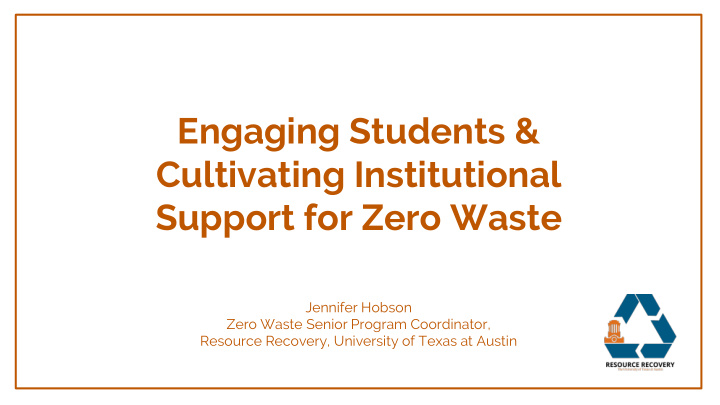



Engaging Students & Cultivating Institutional Support for Zero Waste Jennifer Hobson Zero Waste Senior Program Coordinator, Resource Recovery, University of Texas at Austin
Resource Recovery & Zero Waste at UT Austin • Branch of Facilities Services • Responsible for the efficient reuse and redistribution of campus resources and supporting campus in the implementation of programs to achieve UT Austin’s Zero Waste Goal. • Comprised of the Zero Waste program & Surplus Properties • No direct control of any waste generated on campus other than what is sent to Surplus
UT Austin Stats 51,000 students ▫ 14,000 staff ▫ 430 acre Main Campus and 475 acre J.J. ▫ Pickle Research Campus both located in Austin ▫ Football stadium seats 100,000
Which level of support has been most influential: top-down or bottom-up?
Top-Down Support • Institutional Zero Waste goal outlined in Natural Resources Conservation Plan and reaffirmed in Sustainability Master Plan • Institutional commitment to LEED certification for new buildings • Support for sustainability from leadership • General support for best use of state/university resources
Bottom-Up Support • Students started campus recycling program • Students don’t see recycling as optional • They are paying attention to things around campus- whether they tell you or not • UT Austin’s Green Fee allows students, staff, and faculty apply for funds to implement sustainability initiatives on campus
How to capitalize on this support • Identify people essential to program success • Identify campus sustainability champions • Identify what motivates people that are resistant and/or hesitant but are essential to program success including fiscal responsibility, hierarchy, students, competition etc. • Work with and support internal stakeholders rather than implementing programs from the outside • Learn and communicate using departmental language and motivators • Be committed to the goal not the process • Identify ways to maximize resources and be cost effective
Narrowing the gap between top down and bottom up: incorporating students within operations • Listed departmental needs and gaps • Identified existing campus internship and student engagement programs • Designed internship program to intersect the needs of student engagement programs and Resource Recovery • 2016-2017: 26 students working on 9 projects including: waste audits, outreach, compostable food service packaging, Surplus store, E- Waste, and Lab Equipment.
THANKS! Any questions? Facebook: facebook.com/UTResourceRecovery Jennifer Hobson: Jennifer.Hobson@Austin.utexas.edu 9
Recommend
More recommend